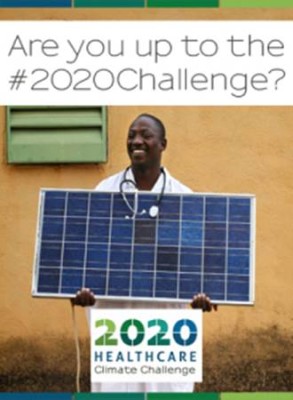With a critically important and life-saving organization like healthcare, it is vital to stay up and running, especially during Mother Nature’s most extreme weather events. How well an organization can bounce back from major challenges like floods, droughts and extreme heat shows their level of resilience. According to Natural Resources Canada, “The impacts of a changing climate are already evident in every region of Canada.” With visible patterns of #Climate Change emerging, as opposed to some remote concept for future generations, hospitals must be prepared now.
What is Climate change?
Climate change refers to a shift in global or regional climate patterns (temperature, precipitation, and wind), particularly in this last century. Though there is a natural level of climate variability, human activity gets the credit for the majority of this change. By burning fossils fuels, people increase the levels of atmospheric carbon dioxide and other greenhouse gases (e.g. methane). These gases “blanket” the planet so when the sun’s rays hit, they cannot bounce back out into space as easily.
According to Environment Canada, over the period 1948 to 2010, the average annual temperature in Canada has warmed by 1.6 °C, a higher rate of warming than in most other regions of the world. Warming is one very large part of climate change, nodding to the earlier term “Global Warming”, though changes to precipitation, wind and extreme weather events are also factors.
What can we expect from climate change?
The World Health Organization (WHO) has reported: “A warmer and more variable climate threatens to lead to higher levels of some air pollutants, increase transmission of diseases through unclean water and through contaminated food, compromise agricultural production in some of the least developed countries, and increase the hazards of extreme weather… like floods and droughts will have a dramatic impact on health.” To sum it up, climate change can bring:
- Rising sea levels with infrastructure impacts to coastal or low-lying settlement
- Heat related illness and death
- Changes in drinking water quality and quantity
- Food security impacts due to changing animal distributions & crop failures
- Health and infrastructure impacts from more severe storms
- Psychosocial impacts from harsher conditions
- Droughts affecting crops
- Water-borne diseases from floods
- Respiratory illness from pollutants like coal plants, forest fires
- Expansion of disease vectors e.g. Lyme Disease, Malaria, Dengue Fever
- Permafrost melt damaging infrastructures
- Increased international conflict & security implications
Is anyone doing something about it?
Just this past December, leaders of the world gathered in Paris for COP21 to hammer out an historic climate agreement. Getting 195 countries to agree on anything is a challenge … doing it while the city still reeled from a major terrorist attack was especially miraculous. The conference was extended until every country agreed to the plan. Whether or not it is strong enough, that there is an agreement is a major accomplishment!
COP21 agreement in a nutshell:
- cap the global temperature rise at 1.5 C
- cut greenhouse gas emissions
- help poorer nations reduce their emissions and adapt to climate change(caused largely by wealthier nations like ours)
- become carbon-neutral by 2050
- check in every 5 years (much like a group weigh-in)
- start NOW!
What can your organization do to be prepared?
Fortunately, the Canadian Coalition for Green Healthcare, with support from the Nova Scotia Department of Environment and Health Canada, has co-developed a “Health Care Facility Climate Change Resiliency Toolkit”. This toolkit can help health care facilities great and small become more resilient to climate-related risks.
Reasons for why your organization should use the tool can be found on the Coalition’s Website greenhealthcare.ca, and include:
- Identify your facility’s current climate change related risks & state of preparedness
- Learn what other facilities are doing
- Help your facility become better prepared
- Benchmark your progress over time and compared to other facilities
- Help start the conversation on climate change-resiliency with hospitals across Canada
On the more worldwide scale, Global Green and Healthy Hospitals is organizing the 2020 Healthcare Climate Challenge. This goal is to mobilize health care around the world to protect public health from climate change, using three main principles:
- Mitigation – by reducing our own organization’s carbon footprint, using less energy, creating less waste
- Resilience – preparing for the impacts
- Leadership – Educating and promoting good public health policies protect public health from climate change
At the recent UN Climate Summit in Paris, Global Green and Healthy Hospitals announced the winners in the 1st annual Climate Champion Awards of the 2020 Health Care Climate Challenge. These awards focused on moving towards low-carbon healthcare by 2020. #University Health Network, where I am privileged to work, received Silver in Energy Efficiency, Gold in Climate Resiliency and Silver in Climate Leadership. From our CEO, Peter Pisters, “This work has never been more important, given Canada’s commitment to create a healthier and sustainable environment at the recent Climate Change summit.”.
![]()
 The 2020 Challenge currently has 69 participants, representing more than 8,900 hospitals and health centers in 20 countries. To participate, see the Global Green & Healthy Hospitals website https://greenhospitals.net/en/participate-challenge/
The 2020 Challenge currently has 69 participants, representing more than 8,900 hospitals and health centers in 20 countries. To participate, see the Global Green & Healthy Hospitals website https://greenhospitals.net/en/participate-challenge/
From the Lancet Commission: “Tackling climate change could be the greatest global health opportunity of the 21st century. Many mitigation and adaptation responses to climate change are “no-regret” options, which lead to direct reductions in the burden of ill-health, enhance community resilience, alleviate poverty, and address global inequity”. Let us all work together to make it so.


